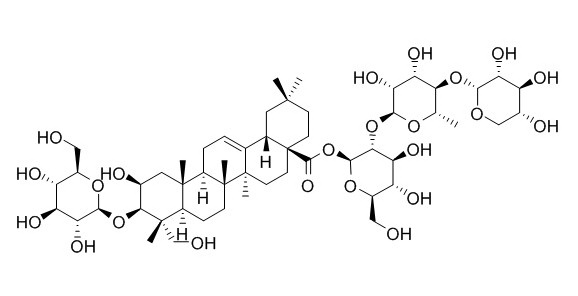Natural Products
Polygalasaponin F
| Catalog No. | CFN90171 |  |
| CAS No. | 882664-74-6 | |
| Molecular Weight: | 1091.3 | |
| Molecular Formula | C53H86O23 | |
| DBs | [PubChem]:274955042 [ChEMBL]: [PCIDB]: |
Standard InChI:
InChI=1S/C53H86O23/c1-22-40(73-43-37(65)31(59)26(58)20-69-43)36(64)39(67)44(70-22)74-41-35(63)33(61)28(19-55)72-46(41)76-47(68)53-14-12-48(2,3)16-24(53)23-8-9-30-49(4)17-25(57)42(75-45-38(66)34(62)32(60)27(18-54)71-45)50(5,21-56)29(49)10-11-52(30,7)51(23,6)13-15-53/h8,22,24-46,54-67H,9-21H2,1-7H3/t22-,24-,25-,26+,27+,28+,29+,30+,31-,32+,33+,34-,35-,36-,37+,38+,39+,40-,41+,42-,43+,44-,45-,46-,49-,50-,51+,52+,53-/m0/s1
Biological Activity
Polygalasaponin F (PG-F), a triterpenoid saponin isolated from Polygala japonica, can induce long-term potentiation in adult rat hippocampus via NMDA receptor activation.[1]
Polygalasaponin F can increase the viability of rotenone-induced PC12 cells, decrease rotenone-induced apoptosis, restore rotenone-induced mitochondrial dysfunction, and suppress rotenone-induced protein expression; PS-F protects PC12 cells against rotenone-induced apoptosis via ameliorating the mitochondrial dysfunction, thus, PS-F may be a potential bioactive compound for the treatment of Parkinson's disease.[2]
Polygalasaponin F can inhibit NF-κB nuclear translocation in a dose-dependent manner, and significantly inhibit the cytotoxicity of conditioned medium prepared by LPS-stimulated BV-2 microglia to neuronal PC12 cells and improve cell viability, it inhibits the secretions of neuroinflammatory cytokines by the regulation of NF-κB-signaling pathway.[3]
Polygalasaponin F has protective effects on PC12 cells injuried by serum deprivation, oxidative stress or oxygen-glucose deprivation.[4]
Product
Official website: Polygalasaponin F
Japanese website: Polygalasaponin F
Chinese website: Polygalasaponin F
Japanese website: Polygalasaponin F
Chinese website: Polygalasaponin F
References
[1] Sun F, Sun J D, Nan N, et al. Acta Pharmacol Sin, 2012, 33(4):431-7.
[2] Wu M M, Yuan Y H, Chen J, et al. J Asian Nat Prod Res, 2014, 16(1):59-69.
[3] Wei W, Yuan Y H, Gao Y N, et al. J Asian Nat Prod Res,, 2014, 16(8):865-75.
[4] Shi R L, Hu J F, Chen N H. International Conference For Physiological Sciences , 2012.
[5] Jiao Q Q, Wang W Y, Juan S U, et al. Journal of Pharmaceutical Practice, 2010, 28(2):137-9.
Product Use Citation





